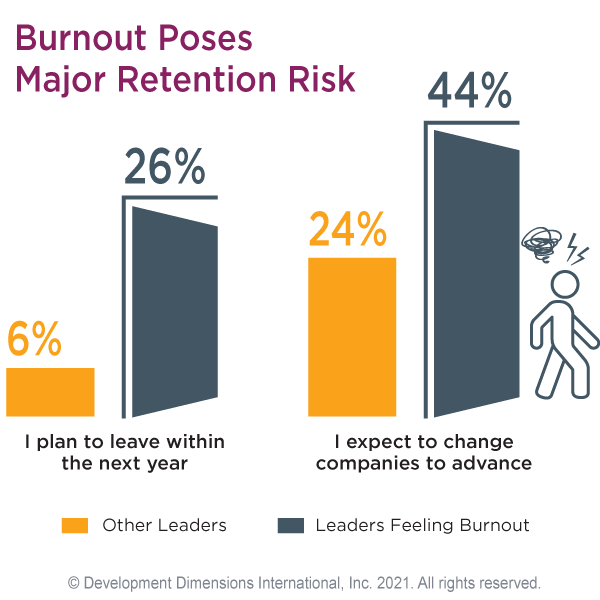If you follow stories and social media about leadership, employees, and work, you can’t miss the varied debates about what’s behind quiet quitting. Many perspectives have emerged from this phenomenon being an age-old challenge of disengaged employees to a reflection of the current state of work. After all, it’s difficult to dismiss the reality of the last almost three years—employees living through a pandemic, taking on more work as workforces shrunk, struggling with mental health and wellbeing, and more.
At DDI, we take the approach that quiet quitting is a shorthand way to refer to toxic things that employees encounter in leaders or workplace culture that impact their ability to show up fully productive every day. We believe that the key competitive differentiator for organizations is making their leaders better at building trusting relationships with employees and engaging in conversations about what they want out of work and how that aligns with the company’s purpose. By having those conversations and taking action to find ways to maximize unique value for the employees, leaders can combat quiet quitting and earn the engagement of their teams, creating a positive, fulfilling, and productive work environment.
How Quiet Quitting Started: 3 Theories
A quick Google search reveals that the first reference to the phrase quiet quitting was used in 2009. However, behaviors of quiet quitters can be found over decades. More recently a viral TikTok popularized the phrase and launched debate and controversy on why employees may be quiet quitters.

Theory #1: Burnout
One theory is that quiet quitting is a result of employees who feel burned out. The COVID pandemic forced a reset for many people to think more about what, where, and how they work. Employees have more choices today about how they work and quiet quitting is one of them. Quiet quitting can be a short-term survival mechanism, but it won’t help the employee or company in the long term because burnout poses a major retention risk. It also leads to mental health and wellbeing concerns.
Theory #2: Multiple Generations at Work
Another theory implies a gap in work values across multiple generations at work. But I always caution against generalizing a generation.
Some—incorrectly—place blame on today’s younger generations in the workplace, including Gen Z and Millennials, saying they are "lazy" and not willing to go above and beyond job duties. Younger generations counter that they are willing to put in the hard work, but are just looking to set healthy boundaries with work.
Others, also incorrectly, accept the narrative that Gen X and Boomers wonder why others were not raised with strong work ethics like themselves.
I once worked for a leader who described his leadership style as “I work to live. I don’t live to work.” Yet, he had a strong work ethic and went above and beyond. That leader was in his 40s, and today, I personally know people in all generations who are currently choosing to quietly quit. So now, more than ever, we cannot assume that only Gen Z and Millennials value their personal lives more than work. Many people of all ages have this opinion.

Theory #3: A New Phrase for an Age-Old Challenge
Yet another theory hypothesizes that quiet quitting is a new phrase for an age-old challenge of disengaged employees not working at full productivity. A recent Gallup study showed that 50% of the U.S. workforce are quiet quitters, a startling statistic.
A commonly cited cause is that employees feel overworked and underappreciated after they took on more work during the pandemic and were not compensated for it. The employee feels the leader has added responsibilities outside of the job description and took nothing off their plates. There are some employees who refuse to take on more work and will only “act their wage,” doing the bare minimum.
What Does Quiet Quitting Look Like in Real Life?
A few weeks ago, I talked with a relative who celebrated one year in his new job out of college. When I asked how it was going, I expected a general “going well” response. But what I heard instead was a list of challenges in his role and at his company.
He shared that morale was poor. People were leaving each week for better companies and more money, and his company was unable to backfill for the vacated roles, meaning more work for everyone else. He went on to say that company leadership is not supportive: his supervisor doesn’t understand the work, makes unreasonable demands of their time, and only points out the negative things they do.
He went on to say that his boss sits in his office all day and only comes out to yell about something someone did wrong. His boss never takes the time to hear their side of what happened.
When I asked him if he was going to stay at the company, he said “I’ll keep my head down, do my work, and stay away from the drama. I need to stay for two years to get the experience and because they can’t find people to do the jobs.” He continued, “I’m getting good opportunities to learn new things. But I don’t want to work for a company long term that treats their employees that way, doesn’t share my values, and doesn’t do anything about the supervisor’s bad behavior.”
I wondered if my relative was a quiet quitter. Was he working at full productivity and giving it his all? Was the organization getting all they should from him? Probably not. Given my role at DDI, I considered how much more productive he would be if he had a better leader.
Signs of Quiet Quitting and What Puts Employees at Risk
The example above provides insight into the factors that put employees at risk for quiet quitting and the signs when someone may be quietly quitting. Review these lists to see if you can spot signs and risks of quiet quitting in your organization or teams.
| Factors that impact quiet quitting: | Quiet quitting behaviors, some of which are more easily observed than others: |
| Excess workload | Avoidance and distance |
| Ineffective manager support | Lack of teamwork |
| Poor communication | Stops volunteering or taking initiative |
| Unclear or shifting expectations | Lack of productivity |
| Blurred boundaries | Lack of passion or enthusiasm |
| Lack of expertise of leader | Putting up more boundaries at work |
| Untrustworthy leaders | Not sharing challenges and conflicts with their manager |
| Inconsistent actions | Stops going above and beyond when completing tasks that they previously overachieved |
| Not investing in development and growth | Waits to be asked to take action that they used to take on their own |
How Is Quiet Quitting Related to Mental Health?
We mentioned earlier that the current state of work and living through the pandemic blurred the lines between home and work. This led to an increase in mental health and wellbeing issues among employees. Many employees are not comfortable telling their leader they are stressed and burned out. It’s important for leaders to be aware of burnout triggers that, if left unresolved, can lead to greater health concerns.
There are times an employee may not even realize they are burning out because they just keep going like the “Little Engine That Could.” Burnout triggers can come from internal forces such as personality. Often, we see this in employees who are people pleasers or overachievers. These may also be characteristics of your high-potential employees. According to Dr. Geri Puleo, burnout triggers can also come from external forces such as poor leadership, work overload, lack of empathy, and bad communication about expectations and boundaries.
What Can Leaders Do to Prevent Quiet Quitting?
While there are many factors at play when it comes to preventing quiet quitting, the role of a leader is clearly key in their employees’ experience of the workplace.
Here are four ways leaders can prevent their employees from quiet quitting:

1. Connect the company's and team’s purpose.
Leaders are responsible for building motivation and dedication in their team members, often by sharing a vision of the organization's or team’s purpose. And leaders should share this vision and purpose with their teams with authenticity and energy!
Additionally, leaders can provide positive feedback when an employee’s work impacts the team's or organization’s purpose. Leaders can also communicate how the work their employees do makes a difference at a broader level.
For example, when a recruiter hires new salespeople, and the team’s onboarding plan enables the new employees to move into their roles faster than expected, supervisors should recognize this achievement by sharing this positive result with the recruiter. This recruiter found the right people for the role, with the right motivation and capabilities. They are making a difference, one person at a time.

2. Build trusting, respectful relationships with direct reports every day.
Connecting with the whole person is key to leader success. Recognizing and addressing the “heart”—people's feelings, such as being respected or appreciated—is as critical as engaging the “head”— accomplishing business outcomes.
Quiet quitters tend to feel underappreciated. When work goes unnoticed and unpraised, employees feel they could underperform or stop without anyone noticing or caring—and they may be correct. So how can leaders make authentic connections with their teams?
It all starts with how leaders connect and interact with their teams. Feelings of appreciation are fostered from interactions that consider each person’s personal needs:
- To be valued
- To be listened to and understood
- To be involved
- To trust and be trusted
- To be supported
Leaders can use DDI’s Key Principles, which form the basics of effective interactions, to consistently meet personal needs in any conversation.
DDI’s 5 Key Principles for Effective Interactions
The Key Principles include:
- Maintain or enhance self-esteem. (This Key Principle can be used to help leaders show their team members appreciation.)
- Listen and respond with empathy.
- Ask for help and encourage involvement.
- Share thoughts, feelings, and rationale. (to build trust)
- Provide support without removing responsibility. (to build ownership)

With quiet quitters, leaders can focus more on self-esteem, empathy, and support to understand what’s important to their team members and what they can do to support them. But leaders shouldn’t forget about the Key Principle on listening in their interactions with quiet quitters. According to organizational psychologist Adam Grant, true leaders are rarely the person in a group who talks the most. True leaders are the people who listen best. They notice and surface what isn’t said.
A quiet quitter isn't going to talk on their own. They likely have lost the motivation. So a good leader is going to listen to what's not being said, observe what behaviors are happening or stopped, or are missing. And by asking questions, then really listening to what's being said and still not being said, the leader can identify what might be motivators for the individual or things within the leader’s control that can be changed, and then use this information to plan how to re-engage the quiet quitter.
Above all, the Key Principles help to create a psychologically safe work environment where employees feel comfortable sharing their thoughts and feelings. But an environment where individuals feel that they can’t share how they are feeling at work, and where there could be fear of retribution for sharing that they are feeling disengaged, encourages employees to remain quiet. The Key Principles create an environment to encourage quiet quitters to talk. And when leaders can get quiet quitters to talk, they can make a difference and re-engage them.
The bottom line here is that while good leadership skills and the Key Principles may seem like common sense, many leaders struggle to make these skills common practice. The key is to have leaders who are positive models of these skills. That way, employees who become new leaders from within, as well as leaders hired externally, know what a good leader looks like.

3. Focus on unique and specific opportunities to add value for employees.
It’s a leader’s job to keep the pulse on their team’s engagement and understand sources of motivation for each team member. Leaders should be aware and courageous in asking questions, demonstrating they care and are listening.
The best retention conversations show employees that their leader and employer recognizes and appreciates them. A great retention conversation can also help leaders identify warning signs that a team member may not be getting everything they need at work and have the potential to be a quiet quitter. Leaders can then build a “stay plan” with strategies to retain their high-performing employees.
Great leaders understand why leadership and employee retention are often talked about together. Employees leave most often because they don’t like their manager. But when an organization’s leaders are advocates for their employees, recognizing, respecting, and appreciating the work of each team member, employees are more likely to stay.
Being an advocate for employees includes understanding what makes employees tick. What do they like or don’t like at work? What do they want to learn? These are just some of the questions every leader should ask during a retention conversation. If leaders are not having meaningful conversations often, maybe once a week with their employees, start now.
Then, once leaders understand more about their employees, they can focus on connecting to what’s important for each. For example, if opportunities for advancement are important, help employees design a plan that will create progress, beyond career development opportunities.

4. Create a work environment that is flexible and optimal for the best work from each unique employee.
Leaders should take time to understand each employee’s boundaries and provide support to maintain them. For example, leaders can support work-life balance by encouraging employees to take breaks, schedule time off, and use vacation days throughout the year.
With quiet quitters, they may not share proactively with their leader the flexibility they may need. But leaders should lead by example, taking days off themselves and modeling a flexible work schedule—working from home when they are ill, or choosing to work fully remotely if this is an option supported by the organization.
If the organization supports hybrid and/or fully remote work, then leaders should fully support employees in their choices here as well. For example, if an employee decides to remain remote while several other team members choose a hybrid working model, leaders can be inclusive of all working styles by running all meetings on Teams or on Zoom, even if some people are in the office together.
But leading a hybrid or remote team effectively definitely takes special leadership skills. To create an environment within the hybrid workplace where employees can be their best, leaders can follow these five best practices.
What Can Organizations Do to Develop a Culture That Combats Quiet Quitting?
At the organizational level, quiet quitting can be curbed when the company has a healthy and inclusive culture. Companies with healthy organizational cultures do these things:
- Frequently survey employees regarding engagement. Ask employees what is going well for them at the company, what can be improved, and if they have ideas or innovations to share. Results are also shared frequently and senior leaders acknowledge the challenges and work together to create a plan to address challenges.
- Train leaders on coaching and retaining employees. Leadership development programs emphasize coaching and leaders learn to have effective retention conversations with their employees.
- Focus on processes and technology that are the biggest barriers to the client and employee experience. Ask: what projects will make the biggest impact on the client experience? And what projects will make the employee experience better? Invest primarily in projects that will have the most impact in these two areas.
- Focus on core job responsibilities when people feel overloaded with work. Ask: what is necessary to do now and what can wait? Leaders empower their employees by giving them space to perform necessary work and take care of themselves outside of work.
In Conclusion:
Better Leaders Can Impact Quiet Quitting
Better leaders build trusting relationships with employees and engage in conversations about what they want out of work and how that aligns with the company’s purpose. Better leaders also create an environment where employees can do their best work. And to do this, better leaders consider the unique needs of their employees by asking the right questions to get them talking and sharing. But the best leaders find ways to meet their employees’ unique needs while also meeting the needs of the business. This is how leaders can best engage quiet quitters and prevent quiet quitting in their organization.
Learn more about DDI’s leadership development courses that can develop skills to boost engagement and prevent quiet quitting, including our new microcourse, “Engaging Quiet Quitters.”
Kelli Buczynski is the Chief People Officer at DDI. Kelli finds her balance spending time outside of work fishing with her husband and two boys and trying new recipes.


